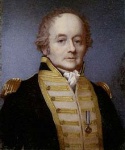HMS Medway (1755)
HMS Medway was a Joseph Allin designed Medway Class 60 gun fourth rate ship of the line, built by M/shipwright John Holland until 1752 when he died, followed by Thomas Fellowes who died in 1753 and completed by Thomas Slade at Deptford Dockyard to the draught specified by the 1745 Establishment. In compliance with this order only certain superficial improvements were made. Ordered on the 28th of March 1751,and laid down on the 13th of June in that year, she was launched on the 14th of February, 1755, and completed on the 26th of March.
Medway
History GREAT BRITAIN Name: HMS Medway Ordered: 25th March1751 Builder: Deptford Dockyard Launched: 14 February 1755 Fate: Broken up, 1811
General characteristicsClass and type: Medway Class 60 gun fourth rate ship of the line Tons burthen: 1204 (bm) Length: 149 ft 4in (45.7 m) (gundeck) Beam: 42 ft 10 in (13.0 m) Depth of hold: 18 ft 6 in (5.6 m) Propulsion: Sails Sail plan: Full rigged ship Armament:
- 60 guns:
- Gundeck: 24 × 24 pdrs
- Upper gundeck: 26 × 18 pdrs
- Quarterdeck: 8 × 6 pdrs
- Forecastle: 2 × 6 pdrs
Service.
HMS Medway was commissioned in the January of 1755 by Captain Peter Denis who commanded her until the 15th of November, 1756. In the July of that year she was dispatched to rendezvous with an inbound convoy from the East Indies, and on the 29th of October she fell in with and took the French privateer Le Marechal de Belleisle.
On the 30th of May 1757, under Captain Charles Proby, whilst cruising off Ushant in company with HMS Eagle, the two ships came sighted the French East Indiaman the Duc d' Aquitaine, of 1,500 tons, mounting 50 long 18 pounders and with a crew of 463 men. After an action lasting an hour they succeeded in taking the Frenchman. The Eagle suffering 10 men killed, whilst the Medway had 10 wounded. This ship was pierced for 64 guns, and was purchased into the Royal Navy.
On the 5th of August Medway captured the 8 gun French privateer La Catherine, followed by the Le Surprent on the 24th of the month.
Next, on the 5th of September she was involved in Lord Hawke’s attempt on Rochefort which was aborted on the 29th due to adverse weather conditions.
On the 16th of February, 1759 Medway sailed for the North American station, and after her return, on the 7th of March 1760 she sailed for the East Indies and commenced her return journey in the February of 1765 and was paid off in the July. On the 23rd of August, of that year she came under Captain John Bladen Tinker who would hold the position until 1774.
Between the 3rd of March 1770 and the May of 1772 Medway was underwent a great repair at Chatham costing £22,565.8.4d. She was recommissioned in the March of 1774 and shortly after recommissioning came under the command of Captain William Affleck until 1780. On the 21st of July in that year she sailed for the Med. We next hear of her in the December of 1778 sailing as reinforcement to the West |indies. On the 6th of July in the following year she took part in the Battle of Grenada Under the command of Rear Admiral Joshua Rowley in the Vanguard of the British Fleet. During the action Medway suffered only 4 wounded.
The April of 1780 found her in action once more when she was present at the Battle of Martinique on the 17th of that month, when Admiral Rodney mauled the French fleet but could not gain a decisive result. Medway suffering t2 killed and 3 wounded in the clash.
On her return to Plymouth under Captain Harry Harmood, in the September of that year she underwent a full refit and coppering between that date and January of 1781 for £9,165.10.1d.
On the 13th of March Medway left for Gibraltar, and arrived on the 12th of April in time to assist in the relief of the port.
On the 12th of December in that year she took part in the action of the second Battle of Ushant in the squadron commanded by Rear Admiral Richard Kempenfelt, and on the day following captured the French privateer Le Genereuse.
On the 11th of January 1782 Captain Alexander Edgar succeeded to the command of Medway and on the 7th of May she sailed to escort a convoy and on her return was paid off on the 21st of April, 1783.
Fate.
She was fitted for Ordinary at Plymouth between the June and August of that year. In 1787 Medway was converted to serve as a receiving ship, and remained in this role until 1811, having been renamed Arundel in 1802. In the March of 1811 she was broken up at Plymouth.








Bookmarks